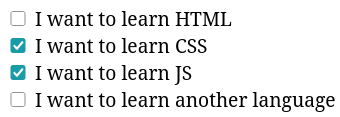HTML: Checkbox
In online stores, purchases are often made by specifying the category that we want to search in. Checkboxes are used to implement multiple choices.
Checkboxes allow you to select multiple items from the ones presented:

Two tags are used to create a checkbox:
- An
<input>withtype="checkbox" - A
<label>tag which will contain the text associated with the checkbox we want
There are two ways to link <label> to <input>:
- Link by
id. To do this you must set a unique id for<input>and link the<label>tag with a checkbox using the for attribute.
<form>
<input id="html" type="checkbox">
<label for="html">I want to learn HTML</label>
</form>- Put
<input>inside the<label>tag. This does not require a uniqueid
<form>
<label>
<input type="checkbox">
I want to learn HTML
</label>
</form>In order to be able to find out which items have been selected after sending the form to the server, the value attribute is used, containing the value that allows you to determine a selected checkbox.
Since there can be many checkboxes on a page and they can belong to different forms, the name attribute is used to define a specific group of checkboxes. Each group of checkboxes has its own name, which you can use to separate groups of checkboxes when processing data on the server.
<form>
<label>
<input type="checkbox" name="languages" value="HTML">
I want to learn HTML
</label>
<br>
<label>
<input type="checkbox" name="languages" value="CSS">
I want to learn CSS
</label>
<br>
<label>
<input type="checkbox" name="languages" value="JS">
I want to learn JS
</label>
</form>Instructions
Create a form with a data handler file at /people. Create two checkboxes inside the form. Link them by putting <input> inside <label>. Don't forget to add the name and value attributes
If you've reached a deadlock it's time to ask your question in the «Discussions». How ask a question correctly:
- Be sure to attach the test output, without it it's almost impossible to figure out what went wrong, even if you show your code. It's complicated for developers to execute code in their heads, but having a mistake before their eyes most probably will be helpful.
Tests are designed so that they test the solution in different ways and against different data. Often the solution works with one kind of input data but doesn't work with others. Check the «Tests» tab to figure this out, you can find hints at the error output.
It's fine. 🙆 One task in programming can be solved in many different ways. If your code passed all tests, it complies with the task conditions.
In some rare cases, the solution may be adjusted to the tests, but this can be seen immediately.
It's hard to make educational materials that will suit everyone. We do our best but there is always something to improve. If you see a material that is not clear to you, describe the problem in “Discussions”. It will be great if you'll write unclear points in the question form. Usually, we need a few days for corrections.
By the way, you can participate in courses improvement. There is a link below to the lessons course code which you can edit right in your browser.
Your exercise will be checked with these tests:
const { test } = require('tests');
test(({ query, expect }) => {
const form = query(document, 'form');
const labels = form.querySelectorAll('label');
expect(form).to.have.attr('action', '/people');
expect(labels).to.have.length(2);
labels.forEach((label) => {
const input = label.querySelector('input');
expect(input).to.have.attr('type', 'checkbox');
expect(input).to.have.attr('name');
expect(input).to.have.attr('value');
});
});Teacher's solution will be available in:
20:00
